► AMG C63 PHEV vs rivals
► It’s a new age of super-estate
► Which loaded weapon comes out on top?
Hot estate warfare recommences as AMG’s radically revised C63 meets the first ever BMW M3 Touring
and the Competition version of Audi’s RS4 Avant
Pre-flight briefing: Mercedes-AMG C63 S E-Performance
Why is it here?
Because the last one beat both M3 and RS4 on its launch and this one is both new and an intriguing roll of the dice from Mercedes-AMG as it shifts from the big V8 that made the C63’s name to the world’s most powerful four-cylinder engine. At least it’s still hand-assembled in Affalterbach to the one-man-one-engine ethos. (Luca Profetto built our test car’s.)
Any clever stuff?
So much stuff. The longitudinally mounted engine alone makes 476bhp and gets an electrically assisted turbo so it can be both huge and lag-free. But this is also a plug-in hybrid with a 6.1kWh battery behind the rear seats, plus an e-motor and two-speed gearbox for the rear axle. It introduces all-wheel drive and adds 201bhp, with total outputs at 670bhp and 752lb ft (but that peak drops by 94bhp after a 10-second boost). There’s also the promise of around eight miles emissions-free. You get eight driving modes, four recuperation modes, a boost mode, drift mode and rear-steer. It’s a lot of stuff.
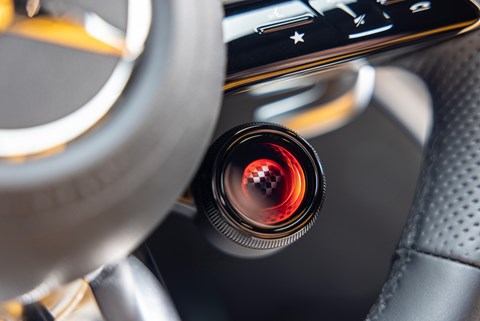
Which version is this?
They’re all S models these days. The estate adds some practicality over the saloon – though it’s a smallest-on-test 324 litres because of the hybrid packaging (and also porkiest at 2115kg).
Pre-flight briefing: BMW M3 Competition Touring
Why is it here?
Long the benchmark, briefly iffy, the BMW M3 is back on form. It won earlier CAR group tests (against RS4, Giulia QF and previous C63) as a saloon and we’ve previously suggested the Touring could be your dream one-car garage.
Any clever stuff?
It’s evolution rather than revolution from the M meisters and no bad thing either. The 3.0-litre twin-turbo straight-six is more progressive and tuneful than its rather diesely forbear and gets more power too, but this time it’s hooked up to an eight-speed auto as standard, where before you could choose between six-speed manual or seven-speed dual-clutch auto. Secure all-wheel drive can flick to full rear-drive lunacy if you dip into the on-screen set-up menu, all while carrying the most stuff on test (500 litres seats up, 1510 litres with them folded). Not so much as mild-hybrid assistance though.
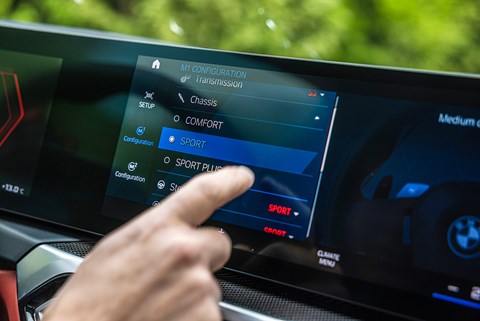
Which version is this?
The Touring is BMW’s first five-door load-lugging M3 after previous dabbles with big-booted M5s. Unlike the M3 saloon and M4 coupe, it comes only in all-wheel drive, but like its UK siblings all Tourings are in Competition spec – meaning 503bhp and 479lb ft to play with.
Pre-flight briefing: Audi RS 4 Competition
Why is it here?
RS4 was once king of the mid-sized fast estates and still commands a devoted following today. It lagged behind the M3 and previous C63 in our last group test, and is now near the end of its life, but Audi is giving it a little boost in the form of the Competition. Like this car’s fetching pastel grey? Us too. All 75 UK-bound cars are Sebring Crystal Black.
Any clever stuff?
Clever? No. Compelling? Absolutely. RS4’s powertrain remains a 2.9-litre twin-turbo V6 with an unchanged 444bhp and 443lb ft but the eight-speed auto’s shifts have been recalibrated for a little extra punch, and you get an RS sports exhaust for a fruitier sort of noise. There’s a reduction in sound insulation at the front bulkhead, adding more noise and saving eight kilos. You also get fixed- rather than variable-rate steering, spanner-adjustable coilover suspension, a retuned rear diff and 20-inch alloys with stickier P Zero Corsa tyres. It’s a very effective polish.
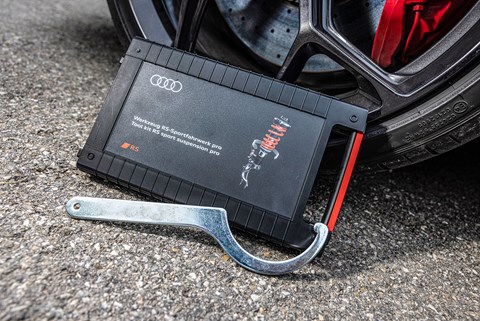
Which version is this?
All RS4 are Avants these days (the RS5 Sportback coupe/saloon is closest to an RS4 saloon). We’re testing the Competition, but you can still order the base Audi RS4 Avant, the Carbon Black or, for near-Competition money, the all-the-toys Vorsprung.
Loaded weapons: AMG C63 vs M3 Touring vs RS4 Competition
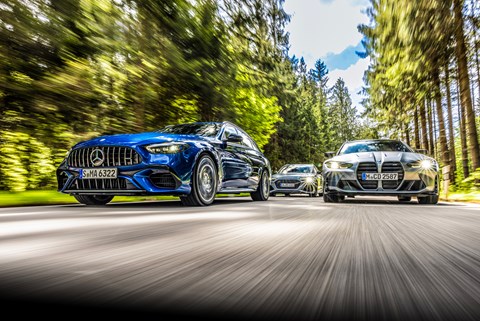
Just a few hours into our four-day test, the frowning and chin-rubbing is in full effect. No, it’s not just you. Yes, I found that too. Maybe we should go for another loop through those hills, just to make sure…
The reason for our collective perplexity? The estate version of the all-new Mercedes-AMG C63, the one that’s ditched the V8 in favour of a hybridised 2.0-litre four. Some months ahead of the Merc’s arrival in the UK, we’ve put it up against its two natural foes. The BMW is the first ever M3 Touring. The Audi is the limited-edition Performance version of the RS4 Avant.
And it soon becomes apparent that there are some pretty serious questions to be answered. Not just the obvious – which is best? – but also some puzzlers around what exactly these cars are for, how versatile they really are, and how they fit into a world that seems to be abandoning estate bodies and high-performance petrol engines.
When Mercedes revealed the details of the new C63 last year, there was a lot of concern about the technical specification. Chiefly, the sheer amount of it; it’s an exceptionally complex powertrain. And there was also the not unrelated question of its weight – well over 2000kg. Had Mercedes-AMG made a strategic mistake in trying to throw so much technology at a mid-sized estate?
First impressions are reassuring: when catapulting off the line fully charged, the C63 is a formidable weapon, launch control or not. Equally impressive is the massive in-gear thrust, the bullet-like throttle action in Race mode, the seamless go-go-go urge, the brutally explosive power even beyond 125mph, and the long, strong legs on an empty German highway.
In isolation, this big-number performance is pretty impressive. But how much of the time do you want to be driving like the world is a drag strip? And how well does the Merc fulfil all the other functions required of a performance estate – functions performed admirably well by its rivals, and by the old C63.
BMW invented the high-performance estate car in 1992 with the 335bhp M5 Touring, which was closely followed by the 268bhp 1993 Mercedes-AMG E36 Estate and the 1994 311bhp Audi RS2 Avant, a joint effort with Porsche. Thirty years down the road, having seen off various rivals, the three German premium brands are again battling it out, even though the estate car – by now an almost exclusively European phenomenon – has over time come under strong pressure from crossovers and SUVs offered by a much wider variety of manufacturers. In addition, these beefed-up, tailgate-equipped family cars are facing increasingly stiff opposition from potent EVs like the Porsche Taycan Sport Turismo, the imminent full-electric BMW i5 M60 Touring and the Audi A6 e-Tron Avant due in 2024.
The new C63 S Estate – like the future E63 AMG and next year’s M5 Touring – boasts a performance hybrid drivetrain designed to combine the best of all worlds: massive power and torque as well as unrivalled efficiency. The other two entrants are more conventional, and less powerful. While the Audi is equipped with a 2.9-litre twin-turbo V6 good for 444bhp and 443lb ft, the 3.0-litre straight-six installed in the M3 Touring is rated at 503bhp and 479lb ft. The hybridised AMG effort easily eclipses both rivals with a massive combined 670bhp and 752lb ft. No contest? Wait and see.
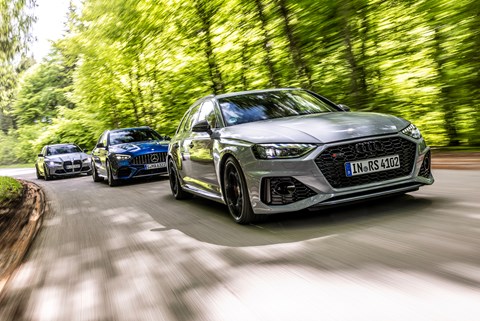
Before we pull out the scorecards, let us zero the mindsets, clear the memory chips and start assessing the entrants from scratch. Why? Because at least two of the three cars differ substantially from driving experiences gathered in the past, because the spec sheets never tell the full story, and because the freshly discovered nuances, detail improvements and the sum of the updates could easily alter the final verdict.
Point in case is the Audi. When did we last have a go in the RS4 Avant? That was back in 2019. It was quick, refined, quite comfy and built like a rock, but it tended to give under pressure. Hampered by too much bodyroll, an irritatingly leisurely transmission, softish brakes lacking confidence, pre-programmed driving modes stacked too close together and oddly indifferent handling, it was merely a fast yet not particularly special estate.
In contrast, our third encounter with the M3 Touring in only four months helps cement the previous assessments. It’s best to avoid the fancy carbonfibre seats unless you are lean of stature and physically fit enough to elegantly mount and dismount from the thinly padded, positively unheated and unventilated buckets which squeeze the thighs together like a clamp and bracket the torso to the car with near-zero tolerance.
We’re keen to have another try at figuring out why BMW gives the driver two settings for steering response and brake action. In Sport, you’d better put on asbestos gloves to avoid getting singed by the ultra-sharp rack-and-pinion set-up. The same goes for the brakes, which are quite grabby in Comfort only to become hyper-reactive in Sport – fine for hardcore track driving, unnecessarily arrhythmic on busy public roads.
And then the C63. The new model is a shock to the system in more ways than one: a totally different experience in terms of speed, sound, steering, stopping, set-up… The C63 S E Performance is no longer a smaller E63; the hybrid metamorphosis turns it into a different animal altogether. There are now two connected drivetrains sharing the propulsion duties and a bulging battery pack riding on top of the rear e-motor assembly which adds several hundred kilos of weight.
While the standard rear-wheel steering enhances the manoeuvrability, the new eight-stage drift mode disconnects the front axle on demand. Is this spectral blue Benz an over-engineered jack-of-all-trades or a breakthrough over-achiever capable of ticking all the right boxes?
For four days in a row, we have to flip coins because everybody wants to drive the Mercedes as it’s the newest car, and the most powerful here. In fact the C63 delivers its peak output only as long as the e-boosted max energy flow lasts, a soberingly brief 10 seconds. That’s of course still plenty to help you accelerate in the advertised 3.4sec from zero to 62mph but not quite enough for the long back straight of a race circuit, for an extended top-speed autobahn stint or even for two consecutive flat-out high-speed overtaking manoeuvres.
The massive 2115kg kerbweight is certainly no help here, nor is the stressed 476bhp 2.0-litre four, which despairs of simultaneously charging the 6.1kWh PHEV battery and setting all four wheels on fire.
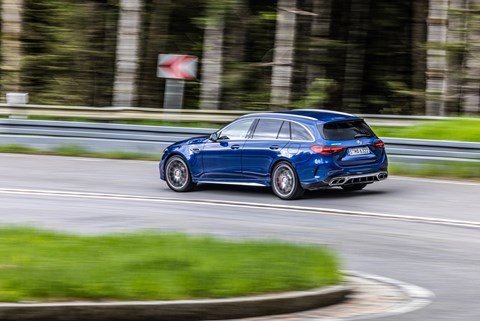
The C63 can cover at most eight emissions-free miles, which emphasises that it’s not a planet-saver but, according to its maker, a luxurious estate car crammed with F1 technology. That includes an electrically-assisted extra-large turbocharger fed by a 400-volt system, a 201bhp e-motor which makes short distances shrink like a zoom lens, and a second gear which kicks in with a vengeance before the e-motor starts yet another climb up the rev ladder.
The only electric energy packs fitted to the Audi and the BMW are the starter batteries. Don’t think of the M3 as a 3-series Touring stuffed with M4 genes; it’s more of an M4 transformed into an extensively redesigned and re-engineered estate. It’s 44mm wider than the base model up front and 38mm more voluptuous in the back, while the body incorporates numerous reinforcement panels, crossbeams and stiffening joints. The changes drive the kerbweight up to a feisty 1865kg, so the Touring also gets recalibrated springs and dampers.
Like the M saloon and coupe, the BMW estate invites you to personalise engine, transmission, dampers, brakes, steering and exhaust in three steps. For road use, we lock the engine in Sport, leave the rest in Comfort and dial in the second-fastest shift speed – that’s about as dynamic as you want. Why not go for even more emotional superfast gearchanges? Because they tend to break the flow, just as the shock absorbers are stretching the friendship in Sport before terminating it in Sport Plus.
Properly warmed up, the front tyres turn in presto and stick as if guided by an invisible induction loop in the road. What follows is an object lesson in the exact opposite of still life painting. With the tarmac as your canvas, the chassis as your easel, the steering as the brush, and the throttle picking and choosing different colours from that infinitely generous palette, every grand g-force-empowered gesture may qualify as a fleeting work of art.
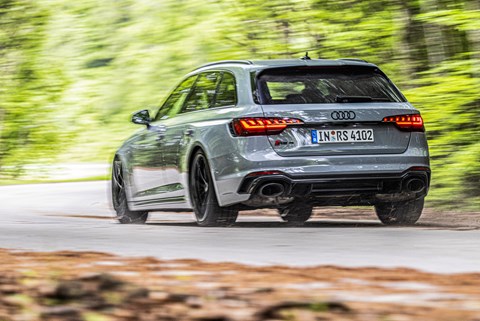
Before model year 2023, the RS4 would have featured exactly nowhere in this contest. But the advent of the limited-run Competition version puts the oldest car in the group back in contention. It brings manually adjustable coilover suspension (RS Sport Suspension Pro, if you must), a 10mm lower ride height, tweaked diff, new exhaust, less sound insulation and a higher top speed. It’s a relatively straightforward DIY job to increase the suspension stiffness by up to 15 per cent. Compression and rebound can be fine-tuned manually with a pair of simple tools in 13 and 16 steps respectively, but the difference between the front and rear axle must never exceed nine clicks to retain a safe handling balance. Only a gimmick? Absolutely not.
Although the Competition does not include the RS3’s Torque Splitter and its tail-happy Torque Rear mode, which sends up to 50 per cent of the grunt to the outer rear wheel, the new set-up developed with the specialist supplier KW completely converts the car’s character.
What used to be a softish, understeer-prone estate car has evolved into a sharp and swift apex chaser capable of building up oodles more grip while remaining flat, fast and composed at all times, especially when running on grippy tyres.
Seems that under the regime of the CTO Oliver Hoffmann and his new Audi Sport deputies Oliver Grams and Rolf Michl, the go-faster division is finally back on track.
So… all three contenders are shaping up as great long-distance mile-eaters, fully certified B-road champs and shirt-sleeved, adrenalin-pumping, Sunday-morning tarmac-peelers. With its immense torque, the C63 quickly establishes itself as the undisputed king of your favourite series of hooligan corners, but because of that narrow 10-second overboost window, it may not be not be the fastest cross country.
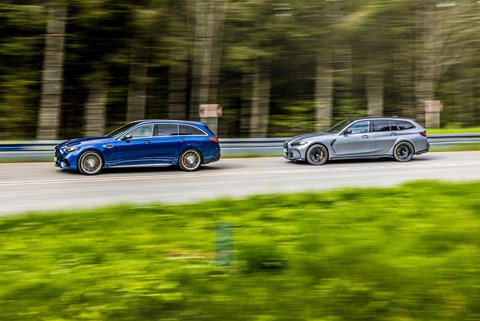
And there are other factors also blunting the Swabian sword. Because of the weight penalty, the tyres heat up quite quickly, grip decreases accordingly early in the game, and as soon as understeer starts setting in you need more and more space to light up the rears for the slide that eventually follows. It’s a vicious circle, even though the power-saving cooling system could hardly be more elaborate, and despite the eerily aggressive recharging algorithm. Worst of all is the lack of consistency. You never really know how fierce the kick in the butt is going to be, nor how long it will last.
The AMG effort picks up bonus points for the – relatively speaking – cushiest ride, most comfortable seats, fastest 0-125mph acceleration time, tightest turning circle, largest cabin, arrow-straight stability and the total absence of any kind of turbo lag. The drift mode, which can be accessed via the shift paddles in Race and Master settings with ESP switched off, automatically deactivates front-wheel drive and directs all that twist action to the rear 275/35ZR20 Michelin Pilot Sport 4S tyres, which yell for help from the word go.
The downsides include the oddly fluctuating power and torque delivery, and the on-test fuel economy of 19.1mpg isn’t much to be proud of for a newly developed hybrid. (Our test figures for the M3 and RS are equally poor, at 19.9 and 18.8mpg respectively.)
One surprise of this shootout is the contenders’ very similar real-life pace, defying the vastly different factory data. Take the RS4, which burns through the 0-62mph sprint in a hand-stopped 3.7sec (against an official 3.9sec) thanks to the brutally pre-loaded launch control, whereas we clock the M3 at 3.3sec (beating the brochure by 0.3sec) while the C63 comes in as promised at 3.4sec.
These results emphasise that the stopwatch is not the key decider. What makes the difference and eventually crowns the winner is the sum of core and fringe talents, with all sorts of emotional incidentals mixed in. The latter category includes ease of use, street cred and distinct delights such as the M1/M2 buttons in the BMW, the Audi’s truly sensational brakes and the telemetrics-centric PlayStation cockpit of the Mercedes.
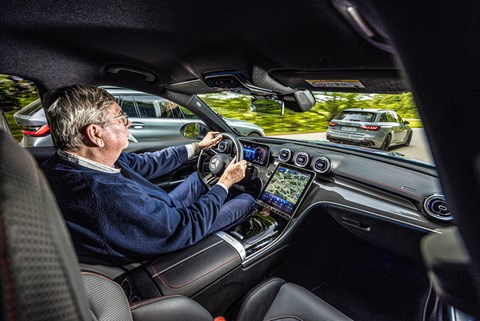
The clock is ticking. We’re coming close to decision time, which will be reached at the end of a final 150-mile loop from the outskirts of Munich to the foothills of the Austrian Alps.
It does not matter how often you swap seats – the M3 is at first always an acquired taste before it gets you firmly hooked five or 10 miles later. Especially in combination with this car’s optional race seats, the BMW feels a touch too firm, stiff, direct, abrupt, binary. The hyper-reactive brakes bite like Jaws, the springs and dampers are uncompromisingly short-fused at low speed, steering and throttle respond with guillotine-like promptness – no grey areas here.
Usher in more revs, build up more speed, get more temperature into the tyres, and the Touring will as a matter of course lead you into its broad and deep comfort zone where compliance never fades even as the individual faculties are rolling out their envelopes in a united quest for the limit.
By now we are going at nine tenths and that initial edginess has long merged with a confidence-building flow buffered by a small but comforting margin for error or exuberance.
And believe it or not, the Audi is still looming large in the mirror of the BMW. On the brakes, it even briefly pulls alongside the M3. With the transmission in Sport and the drive mode in Dynamic, the RS4 conducts the subjectively fastest up- and downshifts. At the same time, the looser rear end masterminded by the revised differential keeps triggering entertaining lift-off-then-turn-in weight transfers.
The overall set-up is still quite relaxed and neutral, and the clever torque vectoring keeps the tyres cool so that they maintain their strong grip even when the driver is in a hurry. Very little drama, awesome pace, total control – that’s the key message conveyed by the RS4 Avant. This multi-talented beast works equally well in Sport and Manual, its torque curve peaks earlier than that of the BMW, the 180mph maximum speed edges both rivals by a whisker. At the same time, the car from Ingolstadt is the most homogeneous daily driver and a fabulous all-rounder. Which makes for some interesting discussions as we end the chin-stroking and announce our verdict…
Final reckoning: AMG C63 vs M3 Touring vs RS4 Competition
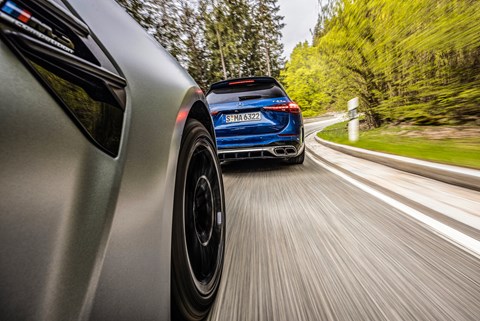
The most power, unreal forward thrust, ultimate digitalisation, some silent-running ability – what could possible deny the Mercedes the win? Answer: a list of flaws longer than that litany of virtues.
For instance, the inadequate boot capacity, compromised by the hybrid hardware sitting above the rear axle. And then there’s the weight, which affects everything – ride, handling, braking, economy… What’s really at fault here is the basic concept, which may have looked irresistible on paper when Mercedes was deciding how to ease AMG into electrification, but simply does not cut it on the road.
Awarding the gold medal to the Audi would give none of our test team a difficult time explaining the decision. Thanks to the expert transformation work at the rejuvenated Sport division, the RS4 Avant is – getting towards the end of its life – a very good car again, just like the MkI version was in 1999.
In this company, the Audi is the proverbial underdog-overachiever, the most smiles-per-mile 24/7 workhorse, a totally forgiving and practical hardcore plaything.
But, on the downside, it is the oldest design here by a long shot, its interface is handicapped by the smallest display and the least intuitive controls, it lacks not only advanced assistance systems but also latest-generation headlights.
But after the RS3 Performance Edition and the run-out R8 V10 GT, the RS4 Avant is again proof that the co-ordinates of Audi’s go-faster satellite are back on target.
Another win then for BMW, but only by a short head, and the smallest change of priority or perspective may make the victory look like a dead heat. The M3 Touring is NOT the best fast family holdall, nor is it a sufficiently sophisticated long-distance grand tourer, or a suitable commuter car for impatient execs. It is, however, the ultimate driving machine for enjoying familiar back roads, for showing that pesky 911 where the hammer hangs when the first raindrops start falling, and for exploring a whole bunch of different limits
Even more so than the Audi, the BMW invites its driver to become one with the machine.
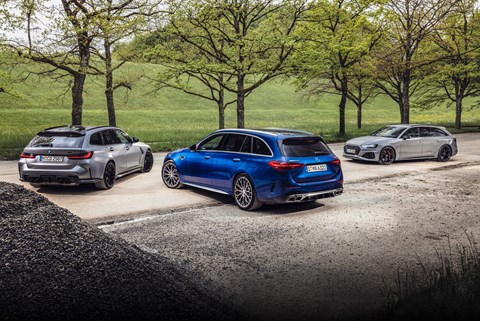
The verdict: AMG C63 vs M3 Touring vs RS4 Competition
First place: BMW M3 Touring
The Touring produces a few extra happy hormones neither rival can muster
Second place: Audi RS4 Competition
The Audi storms back into our affections: best soundtrack, best brakes, best overall balance
Third place: Mercedes-AMG C63 S E-Performance
While the weight of the battery stifles the handling, the drivetrain misses the efficiency goal by a wide margin